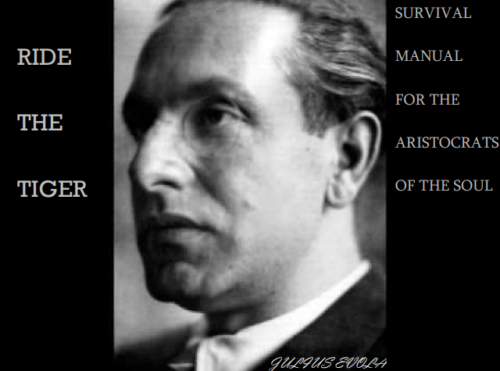
This reading continues on from here.
Part II of Ride the Tiger is called ‘In the World Where God is Dead’, and deals with the ever-present problem of the nihilism that arises when one abandons traditional values. This part consists of nine essays.
The first of these (the third essay in the book), ‘European Nihilism – the Dissolution of Morals’, sets the tone for this section. The subject matter will be familiar to any reader of Nietzsche, and indeed Nietzsche is mentioned in the first paragraph. This essay also mentions Doestoevsky, in the context of “If God is dead, everything is permitted.” It promises to be heavy stuff!
“Rational”, or atheistic morality, has no firm basis, Evola contends. Without an appeal to a higher power, any moral philosophy will eventually be chipped away at by critics until it disintegrates. Moral taboos cannot be justified, and therefore we can’t move past “everything is permitted”.
Perhaps more worryingly, it’s possible that, even if God did exist and inform us all, nothing would really change.
The fourth essay is ‘From the Precursors of Nihilism to the “Lost Youth” and the Protest Movement’. Existence has become absurd, Evola contends, because there are no longer any restraints. Here he traces the advancement of nihilism in the years post-Nietzsche. As Nietzsche predicted, the problem of nihilism only intensified as we entered the 20th century.
Movements such as punks and beatniks are drawn under the wider rubric of nihilists. The counter-culture becomes, for Evola, a “destructive, voiceless rage”. It’s isn’t necessarily that things are bad in and of themselves, but that a quiet, peaceful, mediocre life evokes this rage. Natural man feels little difference between the modern cornucopia of manufactured goods and slavery.
Citing Paul van den Bosch when he wrote that “When we were born, the gold was already transmuted into lead,” Evola makes another appeal to the perennial philosophy and its esoteric nature. This is necessary because the left-wing revolution has “betrayed its origins” with “a new conformism” – a statement that echoes in 2018.
The fifth essay is ‘Disguises of European Nihilism – The Socioeconomic Myth and the Protest Movement’. To Evola’s mind, there are two great socioeconomic myths of our time: the myth of Western prosperity, and the Marxist-communist myth of oppressor versus oppressed. Both myths are predicated on the same falsehood, namely that the signs and markers of the dissolution of society represent “progress”.
One severe problem exists with both of these myths: neither has any room for any conception of a higher world – the realm of gold in alchemism – and so both myths, while they solve the problem of nihilism, introduce unacceptable problems of their own. Both ideologies are predicated on a gross, fundamental error: that solving questions of material suffering will also solve questions of existential suffering.
Perhaps the last words here are “there is no correlation between material and spiritual misery.” This lays out the futility of trying to find absolution through materialist avenues. One is left with the impression, in Evola’s words, that “The time is near of the most despicable οf men, who can nο longer despise himself.”
Are we now in the time of the Man of Clay?
*
If you enjoyed reading this essay, you can get a compilation of the Best VJMP Essays and Articles of 2017 from Amazon for Kindle or Amazon for CreateSpace (for international readers), or TradeMe (for Kiwis).
